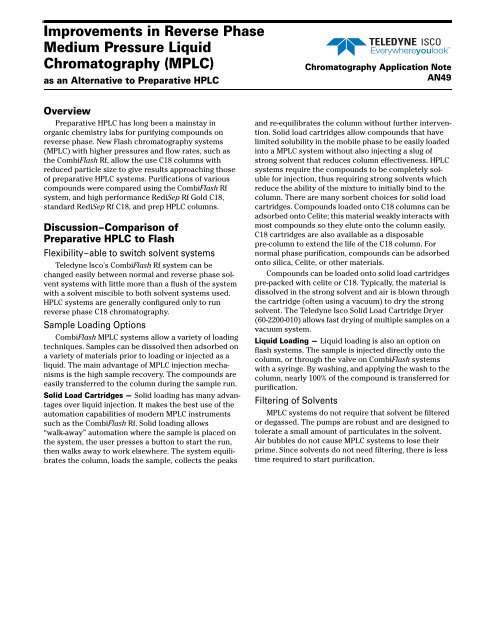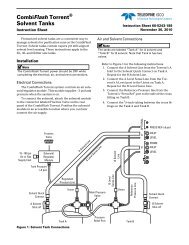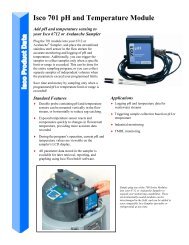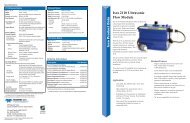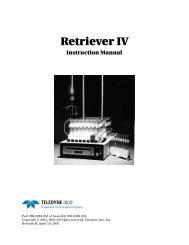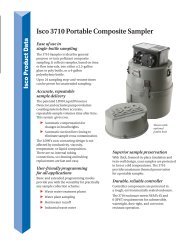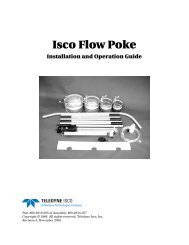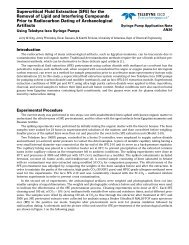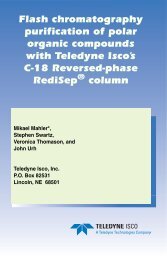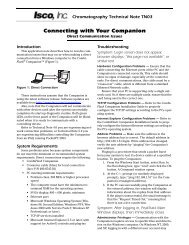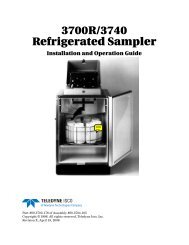Improvements in Reverse Phase Medium Pressure Liquid ... - Isco
Improvements in Reverse Phase Medium Pressure Liquid ... - Isco
Improvements in Reverse Phase Medium Pressure Liquid ... - Isco
You also want an ePaper? Increase the reach of your titles
YUMPU automatically turns print PDFs into web optimized ePapers that Google loves.
<strong>Improvements</strong> <strong>in</strong> <strong>Reverse</strong> <strong>Phase</strong><br />
<strong>Medium</strong> <strong>Pressure</strong> <strong>Liquid</strong><br />
Chromatography (MPLC)<br />
as an Alternative to Preparative HPLC<br />
Chromatography Application Note<br />
AN49<br />
Overview<br />
Preparative HPLC has long been a ma<strong>in</strong>stay <strong>in</strong><br />
organic chemistry labs for purify<strong>in</strong>g compounds on<br />
reverse phase. New Flash chromatography systems<br />
(MPLC) with higher pressures and flow rates, such as<br />
the CombiFlash Rf, allow the use C18 columns with<br />
reduced particle size to give results approach<strong>in</strong>g those<br />
of preparative HPLC systems. Purifications of various<br />
compounds were compared us<strong>in</strong>g the CombiFlash Rf<br />
system, and high performance RediSep Rf Gold C18,<br />
standard RediSep Rf C18, and prep HPLC columns.<br />
Discussion–Comparison of<br />
Preparative HPLC to Flash<br />
Flexibility–able to switch solvent systems<br />
Teledyne <strong>Isco</strong>'s CombiFlash Rf system can be<br />
changed easily between normal and reverse phase solvent<br />
systems with little more than a flush of the system<br />
with a solvent miscible to both solvent systems used.<br />
HPLC systems are generally configured only to run<br />
reverse phase C18 chromatography.<br />
Sample Load<strong>in</strong>g Options<br />
CombiFlash MPLC systems allow a variety of load<strong>in</strong>g<br />
techniques. Samples can be dissolved then adsorbed on<br />
a variety of materials prior to load<strong>in</strong>g or <strong>in</strong>jected as a<br />
liquid. The ma<strong>in</strong> advantage of MPLC <strong>in</strong>jection mechanisms<br />
is the high sample recovery. The compounds are<br />
easily transferred to the column dur<strong>in</strong>g the sample run.<br />
Solid Load Cartridges — Solid load<strong>in</strong>g has many advantages<br />
over liquid <strong>in</strong>jection. It makes the best use of the<br />
automation capabilities of modern MPLC <strong>in</strong>struments<br />
such as the CombiFlash Rf. Solid load<strong>in</strong>g allows<br />
“walk-away” automation where the sample is placed on<br />
the system, the user presses a button to start the run,<br />
then walks away to work elsewhere. The system equilibrates<br />
the column, loads the sample, collects the peaks<br />
and re-equilibrates the column without further <strong>in</strong>tervention.<br />
Solid load cartridges allow compounds that have<br />
limited solubility <strong>in</strong> the mobile phase to be easily loaded<br />
<strong>in</strong>to a MPLC system without also <strong>in</strong>ject<strong>in</strong>g a slug of<br />
strong solvent that reduces column effectiveness. HPLC<br />
systems require the compounds to be completely soluble<br />
for <strong>in</strong>jection, thus requir<strong>in</strong>g strong solvents which<br />
reduce the ability of the mixture to <strong>in</strong>itially b<strong>in</strong>d to the<br />
column. There are many sorbent choices for solid load<br />
cartridges. Compounds loaded onto C18 columns can be<br />
adsorbed onto Celite; this material weakly <strong>in</strong>teracts with<br />
most compounds so they elute onto the column easily.<br />
C18 cartridges are also available as a disposable<br />
pre-column to extend the life of the C18 column. For<br />
normal phase purification, compounds can be adsorbed<br />
onto silica, Celite, or other materials.<br />
Compounds can be loaded onto solid load cartridges<br />
pre-packed with celite or C18. Typically, the material is<br />
dissolved <strong>in</strong> the strong solvent and air is blown through<br />
the cartridge (often us<strong>in</strong>g a vacuum) to dry the strong<br />
solvent. The Teledyne <strong>Isco</strong> Solid Load Cartridge Dryer<br />
(60-2200-010) allows fast dry<strong>in</strong>g of multiple samples on a<br />
vacuum system.<br />
<strong>Liquid</strong> Load<strong>in</strong>g — <strong>Liquid</strong> load<strong>in</strong>g is also an option on<br />
flash systems. The sample is <strong>in</strong>jected directly onto the<br />
column, or through the valve on CombiFlash systems<br />
with a syr<strong>in</strong>ge. By wash<strong>in</strong>g, and apply<strong>in</strong>g the wash to the<br />
column, nearly 100% of the compound is transferred for<br />
purification.<br />
Filter<strong>in</strong>g of Solvents<br />
MPLC systems do not require that solvent be filtered<br />
or degassed. The pumps are robust and are designed to<br />
tolerate a small amount of particulates <strong>in</strong> the solvent.<br />
Air bubbles do not cause MPLC systems to lose their<br />
prime. S<strong>in</strong>ce solvents do not need filter<strong>in</strong>g, there is less<br />
time required to start purification.
Chromatography Application Note AN49<br />
Results and Discussion<br />
Comparison of RediSep Rf C18, RediSep Rf<br />
Gold C18, and HPLC<br />
A mixture conta<strong>in</strong><strong>in</strong>g 5-benzyl-N--N-im-di-t-Boc-<br />
L-His 1 (Compound A) was purified on a CombiFlash Rf<br />
system us<strong>in</strong>g high performance RediSep Rf Gold C18 and<br />
standard RediSep Rf C18 columns. The solvent system<br />
was 5–95% ACN:H 2 O) both conta<strong>in</strong><strong>in</strong>g 0.1% TFA. All<br />
experiments were performed with a detection wavelength<br />
of 214 nm. Figures 1 and 2 demonstrate that the<br />
RediSep Rf Gold C18 column allowed much higher<br />
load<strong>in</strong>g and provided a sharper peak as compared to a<br />
standard RediSep Rf C18 column.<br />
1.50<br />
1.25<br />
Absorbance<br />
.25<br />
0<br />
100<br />
0<br />
%B Solvent<br />
Compound A<br />
O<br />
O<br />
N<br />
H<br />
N<br />
O<br />
OH<br />
0 10 20 30 40 50 CV<br />
Figure 2: CombiFlash Rf system chromatogram of<br />
46 mg purification of Compound A on a 15.5g RediSep Rf<br />
Gold C18 column<br />
The mixture was also purified on an HPLC system<br />
us<strong>in</strong>g the same solvent system (Figure 3).<br />
O<br />
O<br />
N<br />
100<br />
(S)-3-[5-benzyl-1-(tert-butoxycarbonyl)-1H-imidazol-4-yl]-<br />
2-tert-butoxycarbonylam<strong>in</strong>o)propanoic acid<br />
Absorbance<br />
%B Solvent<br />
.80<br />
100<br />
Absorbance<br />
%B Solvent<br />
0 0<br />
Time<br />
Figure 3: Waters DeltaPrep 4000 system purification<br />
of 10 mg sample of Compound A us<strong>in</strong>g a Vydac<br />
10x250 mm column, 5µ particle size<br />
.10<br />
0<br />
0 10 20 30 40 50 CV<br />
Figure 1: CombiFlash Rf system chromatogram of<br />
10 mg purification of Compound A on a 13g RediSep Rf<br />
C18 column<br />
0<br />
Time Sav<strong>in</strong>gs — The CombiFlash Rf system was able to<br />
purify five samples <strong>in</strong> the time required to complete the<br />
first sample on the HPLC system. In the time required to<br />
filter the solvent and sample for prep HPLC, the Combi-<br />
Flash Rf system completed the first two purifications.<br />
After the sample was <strong>in</strong>jected on the prep HPLC system,<br />
three additional samples were purified on the Combi-<br />
Flash Rf system by the time the prep HPLC run was<br />
complete — over a 13-fold <strong>in</strong>crease <strong>in</strong> productivity.<br />
1. The collaboration of Dr. David Smith at Creighton University, School<br />
of Pharmacy, is gratefully acknowledged.
Chromatography Application Note AN49<br />
Compound Purity — The CombiFlash Rf system yielded<br />
purified compounds with the same purity profile as the<br />
prep HPLC system. The ma<strong>in</strong> products from the high<br />
performance RediSep Rf Gold C18 column and the Vydac<br />
column were run on an analytical system (Waters 484<br />
Detector with 600E Controller, 600 Pump, HP 3395 Integrator<br />
with a Waters Symmetry 300Å, 5µ 4.6250 mm<br />
column. Gradient from 5–100% ACN <strong>in</strong> H 2 O, both conta<strong>in</strong><strong>in</strong>g<br />
0.1% TFA over 30 m<strong>in</strong>utes). The analytical HPLC<br />
of both purifications (Figures 4 and 5) are identical.<br />
23.186<br />
Purification of Protected Am<strong>in</strong>oglycoside Antibiotics<br />
on a CombiFlash Companion ®<br />
The optimal flow rate for RediSep Rf Gold C18 columns<br />
is similar to that of silica columns of a similar<br />
dimension—35 mL/m<strong>in</strong>ute for the 15.5 gram column.<br />
However, some older flash systems are unable to run at<br />
optimal flow rates due to the back pressure generated.<br />
The CombiFlash Companion system is limited to 50 psi<br />
back pressure, or a 26 mL/m<strong>in</strong>ute flow rate for the high<br />
performance RediSep Rf Gold C18 column. Despite the<br />
lower flow rate, high performance C18 columns still<br />
show improved resolution compared to standard C18<br />
Flash columns on a CombiFlash Companion system.<br />
2.0<br />
100<br />
START<br />
3.150<br />
Figure 4: Analytical HPLC of Compound A purified<br />
by a CombiFlash Rf system us<strong>in</strong>g a RediSep Rf Gold<br />
C18 column<br />
29.239<br />
STOP<br />
Absorbance<br />
0<br />
0<br />
%B Solvent<br />
23.005<br />
0<br />
2 4 6 8 10<br />
M<strong>in</strong>utes<br />
Figure 6: Protected Am<strong>in</strong>oglycoside purified on a<br />
standard C18 Flash column on a CombiFlash Companion<br />
system<br />
12<br />
START<br />
3.361<br />
Figure 5: Analytical HPLC of Compound A purified<br />
on a DeltaPrep 4000 system us<strong>in</strong>g a Vydac 10x250 mm<br />
column, 5µ particle size<br />
29.266<br />
STOP<br />
2.0<br />
Absorbance<br />
100<br />
%B Solvent<br />
0<br />
0 2 4 6 8 10 12<br />
M<strong>in</strong>utes<br />
0<br />
Figure 7: Protected Am<strong>in</strong>oglycoside purified on a<br />
RediSep Rf Gold C18 Flash column on a CombiFlash<br />
Companion system
Chromatography Application Note AN49<br />
Conclusion<br />
The comb<strong>in</strong>ation of high performance RediSep Rf<br />
Gold C18 columns and CombiFlash systems together<br />
provide purification on reverse phase that approaches<br />
results from prep HPLC. The CombiFlash Rf system is<br />
easy to setup and use. The software is <strong>in</strong>tuitive, allow<strong>in</strong>g<br />
high productivity even from occasional users. The <strong>in</strong>tegrated<br />
design saves valuable bench space.<br />
Table 1: RediSep Rf C18 Columns<br />
Sample Size Column Size Teledyne <strong>Isco</strong> Part Number Description<br />
4.3–86 mg 4.3 g 69-2203-410 4.3 g C18 column, package of 2.<br />
13 – 260 mg 13 g 69-2203-411 13 g C18 column, package of 1.<br />
26 – 520 mg 26 g 69-2203-412 26 g C18 column, package of 1.<br />
43 – 860 mg 43 g 69-2203-413 43 g C18 column, package of 1.<br />
86 mg – 1.72 g 86 g 60-2203-416 86 g C18 column, package of 1.<br />
130 mg – 2.6 g 130 g 69-2203-414 130 g C18 column, package of 1.<br />
240 – 4.8 g 240 g 69-2203-418 240 g C18 column, package of 1.<br />
360 mg – 7.2 g 360 g 69-2203-415 360 g C18 column, package of 1.<br />
Table 2: RediSep Rf Gold High Performance C18 Columns<br />
Sample Size Column Size Teledyne <strong>Isco</strong> Part Number Description<br />
4.3 – 110 mg 5.5 g 69-2203-328 5.5 g High Performance C18 columns, package of 2 columns.<br />
13 – 300 mg 15.5 g 69-2203-334 15.5 g High Performance C18 column, package of 1 column.<br />
26 – 600 mg 30 g 69-2203-335 30 g High Performance C18 column, package of 1 column.<br />
43 – 1000 mg 50 g 69-2203-336 50 g High Performance C18 column, package of 1 column.<br />
86 mg – 2 g 100 g 69-2203-337 100 g High Performance C18 column, package of 1 column.<br />
130 mg – 3 g 150 g 69-2203-338 150 g High Performance C18 column, package of 1 column.<br />
240 – 5.5 g 275 g 69-2203-339 275 g High Performance C18 column, package of 1 column.<br />
360 mg – 8.3 g 415 g 69-2203-341 415 g High Performance C18 column, package of 1 column.<br />
Contact factory for availability.<br />
Table 3: RediSep Rf Empty and C18 Prepacked Solid Load Cartridges<br />
Cartridge Size Teledyne <strong>Isco</strong> Part Number Description<br />
5 g 69-3873-235 Empty universal Rf sample load cartridges (holds up to 5 gram), package of 30. a<br />
25 g 69-3873-240 Empty universal Rf sample load cartridges (holds up to 25 gram), package of 30. a<br />
65 g 69-3873-225 Empty Rf sample load cartridges (holds up to 65 gram), package of 12.<br />
5 g 69-3873-237 Prepacked universal Rf sample load cartridge, 5 gram C18, package of 5. a<br />
25 g 69-3873-242 Prepacked universal Rf sample load cartridge, 25 gram C18, package of 4. a<br />
a. These cartridges (200 psi, one-piece design with locks, no sleeve) require a new Solid Load Cartridge Cap (SLCC) on CombiFlash Rf systems.<br />
Part Numbers: 5 g SLCC, 60-5237-047; 25 g SLCC, 60-5237-048.<br />
CombiFlash, RediSep, and Companion are registered trademarks<br />
of Teledyne <strong>Isco</strong>, Inc. All other trademarks are the<br />
property of their respective holders.<br />
Last modified November 8, 2012<br />
Teledyne <strong>Isco</strong><br />
P.O. Box 82531, L<strong>in</strong>coln, Nebraska, 68501 USA<br />
Toll-free: (800) 228-4373 • Phone: (402) 464-0231 • Fax: (402) 465-3091<br />
E-mail: <strong>Isco</strong>Info@teledyne.com<br />
Teledyne <strong>Isco</strong> is cont<strong>in</strong>ually improv<strong>in</strong>g its products and reserves the right to change product<br />
specifications, replacement parts, schematics, and <strong>in</strong>structions without notice.


